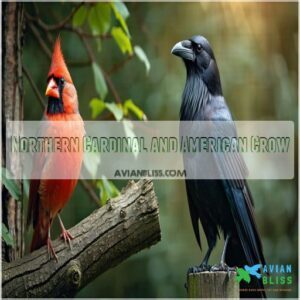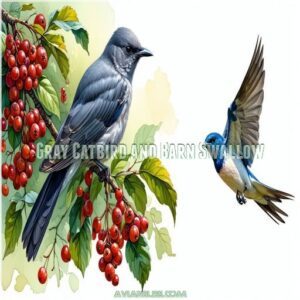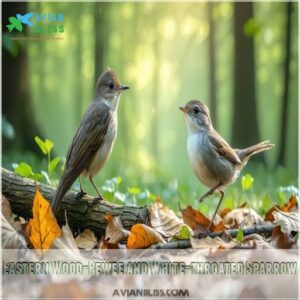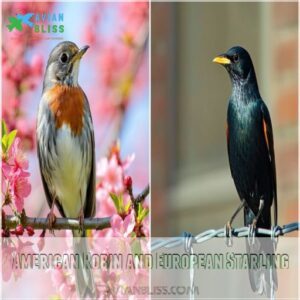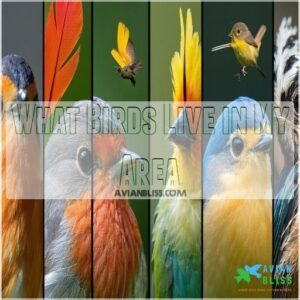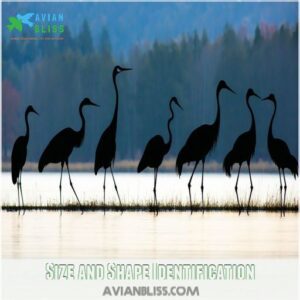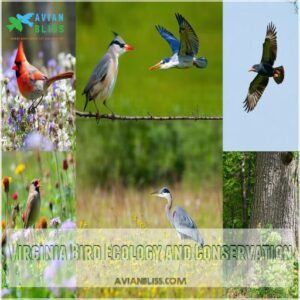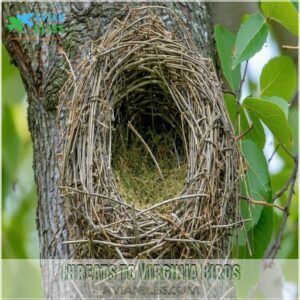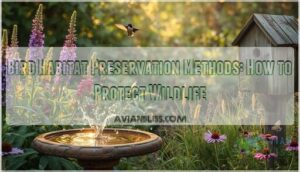This site is supported by our readers. We may earn a commission, at no cost to you, if you purchase through links.
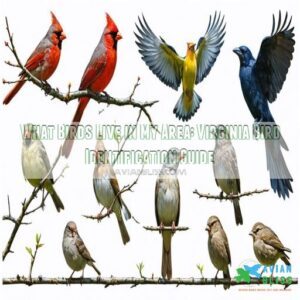
Start by scanning your local landscape for colorful characters like the vibrant Northern Cardinal or the intelligent American Crow.
Grab your binoculars and focus on key details: bill shape, size, and habitat. Use free apps like eBird to track local species, and pay attention to distinctive songs and behaviors.
Urban green spaces and backyard feeders are goldmines for spotting Carolina Wrens, Mourning Doves, and other winged neighbors.
Your neighborhood’s avian world is waiting to be discovered – are you ready to become a backyard bird detective?
Table Of Contents
- Key Takeaways
- Virginia Bird Species Overview
- What Birds Live in My Area
- Identifying Birds in Virginia
- Bird Habitats and Distribution
- Backyard Birds Found in Virginia
- Virginia Bird Ecology and Conservation
- Threats to Virginia Birds
- Tips for Observing and Identifying Virginia Birds
- Frequently Asked Questions (FAQs)
- How do I find out what birds are in my area?
- How do I identify a bird I found?
- Is there a totally free bird identification app?
- What is the most common bird in NY?
- How do migrating birds find their way home?
- Can birds recognize individual humans nearby?
- Why do some birds flock together?
- How long do wild birds typically live?
- Do urban environments change bird behaviors?
- Conclusion
Key Takeaways
- Check out apps like Merlin Bird ID or Audubon to quickly identify birds in your area by photo or song.
- Focus on key details like size, shape, bill, and habitat to pinpoint bird species accurately.
- Create bird-friendly habitats with native plants, clean water sources, and diverse feeders to attract various species.
- Learn bird songs, behaviors, and seasonal migration patterns to enhance your birdwatching skills.
Virginia Bird Species Overview
If you’re curious about the feathered friends that call Virginia home, you’ve landed in the right place.
From the vibrant Northern Cardinal to the clever American Crow, Virginia’s diverse landscapes host a fascinating array of bird species.
your backyard birdwatching adventure will be truly exciting.
Northern Cardinal and American Crow
Spotting the vibrant Northern Cardinal and crafty American Crow is a bird-watcher’s delight in Virginia.
These distinctive species showcase unique characteristics: cardinals flash brilliant red plumage, while crows display remarkable intelligence.
Their overlapping urban and woodland habitats make them common sights, with distinctive cardinal songs and crow calls helping birdwatchers quickly identify these fascinating Virginia natives.
As part of Virginia’s Avian Biodiversity, they contribute to the state’s diverse ecosystems.
Carolina Wren and Mourning Dove
Though small in size, the Carolina Wren and Mourning Dove stand out in Virginia’s bird landscape with unique characteristics.
The wren’s loud, bubbling song contrasts sharply with the dove’s soft cooing, while their nest-building techniques differ dramatically.
These birds share urban and woodland habitats, offering birdwatchers a delightful glimpse into Virginia’s diverse avian landscape.
Birders looking to identify the Carolina Wren can use resources like Carolina Wren identification to learn more about this species.
Indigo Bunting and Red-eyed Vireo
The vibrant blue Indigo Bunting and the melodious Red-eyed Vireo are summer visitors that paint Virginia with life.
These bird species showcase unique song comparisons and nesting habits.
Birders can identify them by their distinctive calls and habitat overlap in forest edges.
Their migration timing and conservation status make them fascinating subjects for Virginia bird enthusiasts.
Gray Catbird and Barn Swallow
Meet two of Virginia’s most fascinating feathered friends: the Gray Catbird and Barn Swallow.
These birds showcase impressive adaptability, with catbirds mimicking complex songs and swallows performing aerial acrobatics during nest building.
Their unique behaviors and habitat overlap make them standout species in Virginia’s diverse bird population, offering bird enthusiasts a glimpse into the intricate world of local avian life.
Gray Catbird and Barn Swallow
Eastern Wood-Pewee and White-throated Sparrow
After exploring the Gray Catbird‘s quirky personality, we’ll zoom in on two Virginia birds with distinct characters. Eastern Wood-Pewees whisper soft, melancholic calls from forest canopies, while White-throated Sparrows hop along woodland edges.
Their unique traits make bird identification a thrilling treasure hunt:
- Listen for the Wood-Pewee’s plaintive "pee-a-wee" song
- Spot the sparrow’s distinctive white throat patch
- Track their migration patterns across Virginia’s diverse landscapes
Dark-eyed Junco and Yellow-rumped Warbler
Winter’s feathered visitors, Dark-eyed Juncos and Yellow-rumped Warblers, dance through Virginia’s landscapes with distinctive charm.
These small songbirds bring life to backyard feeders and forest edges, showcasing unique Junco migration patterns and Warbler diet adaptations.
Their presence signals seasonal shifts, offering birdwatchers a delightful glimpse into the dynamic world of Virginia’s avian residents.
unique Junco migration patterns and Warbler diet adaptations.
Chipping Sparrow and Brown-headed Cowbird
Those tiny Chipping Sparrows might look like nature’s afterthoughts, but they’re masters of adaptation in Virginia’s diverse landscapes. Their distinctive rusty cap and trilling bird song make them stand out among backyard visitors.
Meanwhile, the Brown-headed Cowbird plays a cunning game of brood parasitism, laying eggs in other birds’ nests – a survival strategy that’s both fascinating and controversial in bird species identification.
For a detailed guide to identifying these and other species, check out a Virginia bird guide.
American Robin and European Starling
If you’ve been tracking sparrows, get ready to meet two of Virginia’s most common backyard visitors: the American Robin and European Starling. These birds might look similar at first glance, but they’re as different as can be.
- Robins symbolize spring’s hopeful return
- Starlings bring urban wildness to your backyard
- Each bird tells a unique ecological story
- Nature’s diversity starts right outside your window
Their size, diet, and habitat preferences reveal fascinating differences that’ll turn you into a backyard bird detective.
What Birds Live in My Area
You’ll love discovering the incredible diversity of birds that call Virginia home, from coastal regions to urban landscapes.
By understanding their unique characteristics and habitats, you’ll become a skilled bird enthusiast.
You’ll become a skilled bird enthusiast who can identify and appreciate the feathered friends residing in your local environment.
Birds Found in Virginia Beach
While Virginia Beach boasts a vibrant bird population, you’ll spot everything from coastal shorebirds to backyard regulars.
Grab your binoculars and local bird guides to explore seasonal variations at birdwatching hotspots.
Whether you’re using a bird identification app or practicing citizen science, you’ll discover a feathered world right in your coastal backyard.
Birds Found in Richmond
Nestled along the James River, Richmond offers a bird lover’s paradise with over 100 species calling the city home.
From urban parks to historic cemeteries, you’ll spot Carolina Wrens, Northern Cardinals, and Blue Jays flitting about.
Grab your binoculars and download the Merlin Bird ID app to identify Richmond’s feathered residents quickly.
Birds Found in Fredericksburg/Alexandria
After exploring Richmond’s avian wonders, bird enthusiasts in Fredericksburg and Alexandria have a treasure trove of feathered friends to discover.
Your local bird identification adventure takes flight with these top sightings:
- Vibrant Northern Cardinals dancing through suburban landscapes
- Carolina Wrens serenading from backyard shrubs
- Persistent House Sparrows claiming territory
- Migratory songbirds painting the sky with their seasonal journey
Birds Found in Roanoke
Your Roanoke bird adventure begins with a diverse ecosystem that hosts an impressive array of feathered friends.
From urban parks to mountain edges, the city offers birdwatching opportunities that’ll make any nature enthusiast’s heart flutter.
| Bird Species | Typical Habitat |
|---|---|
| Blue Jay | Wooded Areas |
| Carolina Wren | Backyard Shrubs |
| American Robin | Lawns & Gardens |
| Northern Cardinal | Forest Edges |
| Downy Woodpecker | Tree Clusters |
Identifying Birds in Virginia
You’ll find Virginia’s diverse bird populations are easier to identify when you know what to look for.
By learning about bill shape, habitat, size, and key characteristics, you’ll quickly become an expert at spotting the feathered friends that call the Old Dominion home.
Size and Shape Identification
Want to become a bird detective? Size and shape are your secret weapons in bird identification.
Snap a mental picture of a bird’s overall silhouette – is it sparrow-sized or crow-massive?
Check out a bird’s posture, wingspan, and other visual clues to decipher the mysteries of local bird species faster than you can say "chirp".
Compare, observe, and conquer!
Bill Shape Identification
Size might tell you a bird’s story, but bill shapes whisper their secrets!
From the pointy beaks of woodpeckers to the curved hooks of raptors, each beak reveals feeding habits and species clues.
Grab your local bird identification guide and start matching those distinctive bill shapes – they’re like nature’s signature for identifying Virginia’s feathered friends.
Habitat and Distribution
After pinpointing bill shapes, understanding habitat and distribution becomes your secret weapon in bird identification.
Virginia’s landscape offers a treasure map of bird species, with eBird data revealing migration patterns and nearby bird populations.
Range maps showcase how local environments shape where Virginia bird species call home, painting a vivid picture of avian life across different regions.
By studying the bird feeder preferences of common species, such as American Goldfinch’s love for nyjer seeds, you can better understand the specific needs of the birds in your area.
Water Sources and Bird Feeder Preferences
From mapping bird habitats, we now zero in on attracting feathered friends.
Bird baths and feeders are your backyard’s welcome mat for nearby bird species.
Strategic water placement and smart seed choices can transform your space into a bird paradise.
Different feeder types appeal to specific backyard birds, turning your yard into a bustling avian hotspot. This makes for a great bird paradise.
Bird Habitats and Distribution
Virginia’s diverse landscapes offer a rich tapestry of bird habitats, from coastal marshes to urban parks.
where you’ll find a fascinating array of feathered residents.
By understanding the unique distribution patterns and regional variations, you’ll discover the secrets of where to spot different bird species across the state’s varied environments. bird habitats and bird species
Coastal Environments
The Virginia coastline transforms into a vibrant ecosystem teeming with unique bird species adapted to salt-swept environments. Coastal bird adaptations reveal nature’s incredible resilience in challenging maritime habitats.
- Beach nesting sites provide critical breeding grounds for shorebirds
- Salt marsh avifauna showcase remarkable survival strategies
- Shoreline bird surveys track migration patterns and population dynamics
Grab your binoculars and explore these dynamic coastal landscapes where feathered residents thrive.
Urban Areas
Virginia’s urban landscapes teem with surprising bird life, transforming concrete jungles into unexpected wildlife havens.
City dwellers can spot adaptable species like European Starlings and House Sparrows thriving amid noise and buildings.
To further explore the urban bird scene, using a bird identification app can be a valuable tool.
Bird feeders and green spaces create vital urban habitats, supporting diverse populations that have mastered finding their way through human-dominated environments.
Understanding these urban bird adaptations reveals nature’s incredible resilience.
Regional Variations in Bird Populations
Spotting birds across Virginia reveals a fascinating patchwork of regional diversity that’ll make any nature lover’s heart sing.
Understanding regional variations in bird populations means diving into the complex world of avian distribution:
- Coastal regions host unique shorebird species
- Mountain zones support different bird communities
- Urban landscapes attract adaptable bird species
- Piedmont areas showcase mixed habitat bird populations
These variations paint a vibrant picture of Virginia’s winged inhabitants.
EBird Data for Tracking Bird Sightings
Want to know which feathered friends are hanging out in your neck of the woods?
eBird data transforms everyday birders into citizen scientists, offering mind-blowing range maps and species trends right at your fingertips.
By tapping into the sphere of bird habitat identification, you can gain valuable insights into the environments where birds thrive.
With just a few clicks, you’ll track local bird sightings, visualize population movements, and gain a better understanding of what birds actually live near you.
Backyard Birds Found in Virginia
If you’re wondering which feathered friends might visit your Virginia backyard, you’re in for a delightful surprise!
From the soft cooing of Mourning Doves to the acrobatic hops of White-breasted Nuthatches,
your outdoor space can become a vibrant hub of avian activity.
Mourning Dove
Gracefully gliding through Virginia’s backyards, the Mourning Dove (Zenaida macrocula) stands out as a familiar feathered friend. These gentle birds bring subtle beauty to your outdoor spaces with their soft gray plumage and distinctive cooing calls.
- Learn their unique dove calls to master bird identification
- Observe their remarkable nesting habits in trees and shrubs
- Track their impressive migration patterns across different landscapes
These backyard regulars showcase nature’s understated elegance.
White-breasted Nuthatch
Perched headfirst on tree trunks, the White-breasted Nuthatch defies gravity with its unique climbing style. This small, agile bird brings energy to Virginia backyards, sporting a crisp white belly and slate-gray back.
| Feature | Description |
|---|---|
| Size | 5-6 inches long |
| Color | White belly, blue-gray back |
| Sound | Nasal "yank-yank" call |
| Behavior | Climbs trees headfirst |
Nuthatches feast on insects, seeds, and bark-dwelling treats, making them fascinating backyard visitors.
Dark-eyed Junco
The winter’s feathered friend, the Dark-eyed Junco, dots Virginia’s backyards like salt on pepper.
These slate-gray birds hop around ground feeders, munching seeds and creating a lively dance during colder months.
With multiple subspecies calling your backyard home, you’ll spot these Junco migration masters easily, their white belly flashes and distinctive songs marking their presence in your local landscape.
Song Sparrow
If the Dark-eyed Junco caught your eye, wait until you meet the Song Sparrow—a backyard hero that’ll make your bird identification skills sing.
These adaptable birds belt out complex melodies, sporting streaky brown feathers that blend perfectly with Virginia’s diverse landscapes.
Their cheerful song and widespread presence make them a favorite among backyard bird enthusiasts.
Song Sparrows also enjoy sunflower seeds, which are a great addition to any bird-friendly landscape.
Black-capped and Carolina Chickadees
Curious birders might spot two distinct chickadee species flitting through Virginia’s backyards: the Carolina and Black-capped Chickadees.
These tiny acrobats sport similar black-and-white plumage but differ subtly in range and song.
Carolina Chickadees dominate southern regions, while their northern cousins prefer cooler territories.
Masters of winter survival, they’ll charm you with their distinctive "chick-a-dee-dee-dee" calls that slice through frosty air.
Virginia Bird Ecology and Conservation
You’ll discover how Virginia’s birds play essential roles in maintaining local ecosystems and balancing complex interactions between species.
By understanding their ecological significance, you’ll learn why conservation efforts are necessary for protecting native bird populations and addressing challenges from invasive species.
Role in The Ecosystem
Virginia’s birds are nature’s unsung heroes, weaving intricate food webs that keep ecosystems thriving.
From tiny Carolina Wrens to majestic Blue Jays, these feathered friends play essential roles in seed dispersal, pest control, and pollination.
They’re the silent guardians maintaining balance in our local landscapes, transforming gardens and forests into vibrant, interconnected living systems that sustain life in remarkable ways. These feathered friends are essential to the ecosystem.
Interactions With Other Species
As ecosystems buzz with life, birds engage in complex interactions that shape their survival and relationships. Understanding these dynamics offers a window into nature’s intricate social network.
Bird species in Virginia showcase remarkable ways of coexisting and competing:
- Predator-prey relationships determine survival strategies
- Competitive interactions influence territorial behaviors
- Mutualistic exchanges support ecosystem balance
- Symbiotic connections reveal nature’s interconnectedness
These interactions create a delicate dance of survival and adaptation across Virginia’s diverse habitats.
Conservation Concerns
Amid the whispers of forest and field, Virginia’s bird species face mounting conservation challenges that demand our attention.
Habitat loss chips away at vital breeding grounds.
Climate shifts disrupt migration patterns and food availability.
These pressures squeeze bird populations, pushing some species closer to the brink of survival in an increasingly unpredictable landscape.
Impact of Invasive Species
When conservation efforts hit roadblocks, invasive species emerge as silent troublemakers in Virginia’s bird ecosystems.
House Sparrows and European Starlings crowd out native birds, disrupting delicate ecological balances.
They compete ruthlessly for nesting sites, food, and territory, spreading diseases and altering habitats. These feathered invaders challenge local bird populations, making identification and monitoring critical for protecting Virginia’s native winged residents. This is a significant conservation challenge. The invasive species impact is substantial.
Threats to Virginia Birds
As a Virginia bird enthusiast, you’ll want to understand the critical challenges facing your local feathered friends.
Climate change, habitat destruction, invasive species, and pollution are dramatically altering the landscapes where birds live, breed, and survive.
Habitat Loss and Fragmentation
The consequences of habitat loss and fragmentation hit Virginia’s bird populations hard. Urban sprawl and land-use changes slice through natural landscapes like a knife, leaving bird species struggling to survive. Wildlife corridors become critical lifelines.
- Shrinking green spaces destroy nesting grounds
- Fragmented habitats disrupt migration patterns
- Reduced genetic diversity threatens species survival
- Isolated populations face increased extinction risks
Human development carves up bird territories, forcing adaptations or local extinctions.
Climate Change
As habitat loss shrinks bird territories, climate change compounds the challenge.
Shifting temperatures scramble migration patterns, pushing bird species outside their comfort zones.
Warmer winters disrupt breeding cycles, while unpredictable weather threatens food sources.
Virginia’s feathered friends face an uncertain future, with some species struggling to adapt to rapidly changing landscapes and ecosystems.
Invasive Species
Climate change disrupts ecosystems, paving the way for invasive species to wreak havoc on Virginia’s bird populations.
House Sparrows and European Starlings muscle out native birds, causing ecological chaos.
These aggressive invaders outcompete local species for nesting sites and food, dramatically altering bird communities and threatening the delicate balance of Virginia’s diverse avian landscape.
Pollution
Invasive pollutants wreak havoc on bird populations, turning their vibrant habitats into danger zones.
Air and water contamination disrupt food sources, damage respiratory systems, and alter landscapes.
Birds near me struggle to survive as nitrogen oxides, selenium, and other toxic chemicals chip away at their delicate ecosystems, making bird identification apps a critical tool for tracking these vulnerable species.
Tips for Observing and Identifying Virginia Birds
If you’re enthusiastic to spot Virginia’s diverse bird species, you’ll need a keen eye and the right tools to identify them accurately.
By understanding bird behavior, habitat preferences, and using modern technology like identification apps,
you’ll transform your backyard into a thrilling birdwatching sanctuary.
Bird Feeding and Watering
During the crisp morning hours, transforming your backyard into a bird paradise starts with strategic feeding and watering techniques that attract Virginia’s vibrant feathered friends.
- Choose high-quality seed mixes targeting specific bird species
- Offer diverse food options like sunflower seeds and suet
- Create multiple feeding stations to reduce competition
- Position feeders near natural shelter for safety
- Maintain clean water sources and feeders regularly
Bird-Friendly Habitats
From your backyard to local parks, creating bird-friendly habitats is like rolling out the welcome mat for feathered friends. Native plants, water sources, and safe spaces transform ordinary landscapes into bird havens.
| Habitat Element | Bird Attraction Strategy |
|---|---|
| Native Plants | Provide natural food and shelter |
| Water Sources | Attract birds for drinking/bathing |
| Shelter Areas | Offer protection from predators |
| Diverse Vegetation | Create multiple feeding zones |
| Minimal Pesticides | Support a healthy ecosystem |
Bird Identification Apps
After creating a bird-friendly habitat, you’ll want to level up your bird identification skills with powerful smartphone apps.
These digital companions can turn you into a birding pro in no time.
Check out these must-have bird identification tools:
- App reviews highlight top-rated bird spotting apps with incredible accuracy
- Identify birds by picture using cutting-edge bird identification software
- Find free and paid options that match your budget and bird identification needs
Frequently Asked Questions (FAQs)
How do I find out what birds are in my area?
Baffled by backyard birds?
Snap a pic or listen closely with Merlin or Audubon apps.
These digital guides will help you quickly identify feathered friends, turning your curiosity into expert-level bird knowledge in no time.
How do I identify a bird I found?
Check the bird’s size, color, shape, and bill.
Use a field guide or bird identification app like Merlin.
Note its habitat, behavior, and unique markings.
Compare your observations to local species to pinpoint the exact bird you’ve spotted.
Is there a totally free bird identification app?
Merlin Bird ID app is your ticket to free, quick bird identification.
Snap a photo or describe what you see, and it’ll instantly help you ID birds anywhere.
It offers offline capabilities and a handy life list feature.
What is the most common bird in NY?
Like a feathered symphony painting the sky, the Blue Jay emerges as New York’s most common avian resident.
You’ll spot these vibrant, noisy birds everywhere from city parks to rural landscapes, their bold blue plumage catching your eye with each distinctive call.
How do migrating birds find their way home?
You’ll marvel at how birds navigate using an incredible internal GPS.
magnetic fields, celestial cues, landmarks, and inherited genetic maps guide them.
across continents with astonishing precision during their epic migratory journeys.
Can birds recognize individual humans nearby?
Yes, many birds, like crows and ravens, can recognize individual human faces.
They remember people who feed or threaten them, using advanced cognitive abilities to distinguish between specific humans in their environment.
Why do some birds flock together?
Imagine birds as a team huddling for survival, sharing warmth and protection.
They flock together to dodge predators.
They flock together to find food more efficiently.
They flock together to navigate challenging migrations.
They flock together to communicate critical survival information in their dynamic social networks.
How long do wild birds typically live?
Wild birds’ lifespans vary dramatically, with smaller songbirds typically living 3-5 years, while larger birds like hawks can survive 10-20 years.
Factors such as habitat, predation, and environmental conditions substantially influence a bird’s longevity in nature.
Do urban environments change bird behaviors?
Urban environments do shift bird behavior.
You’ll see birds adapt by changing feeding habits.
Some even stick around year-round, skipping migration.
Birds also adapt by nesting in unusual spots like streetlights, or singing louder to compete with city noise.
Conclusion
Discovering what birds live in your area is like opening a window to nature’s hidden world.
Virginia offers treasures like the Northern Cardinal, Mourning Dove, and Yellow-rumped Warbler ready to be spotted.
With tools like eBird, a pair of binoculars, and some practice, you’ll quickly learn to recognize species by size, shape, and song.
Whether in your backyard or exploring coastal habitats, bird identification adds a layer of wonder to your days—start your own adventure today!

